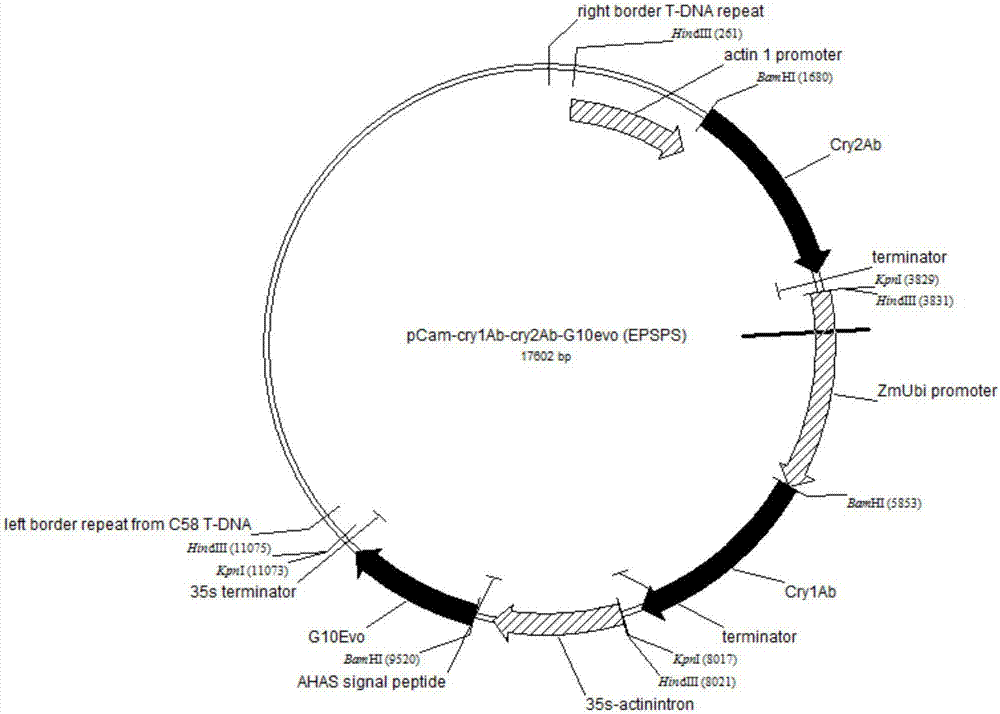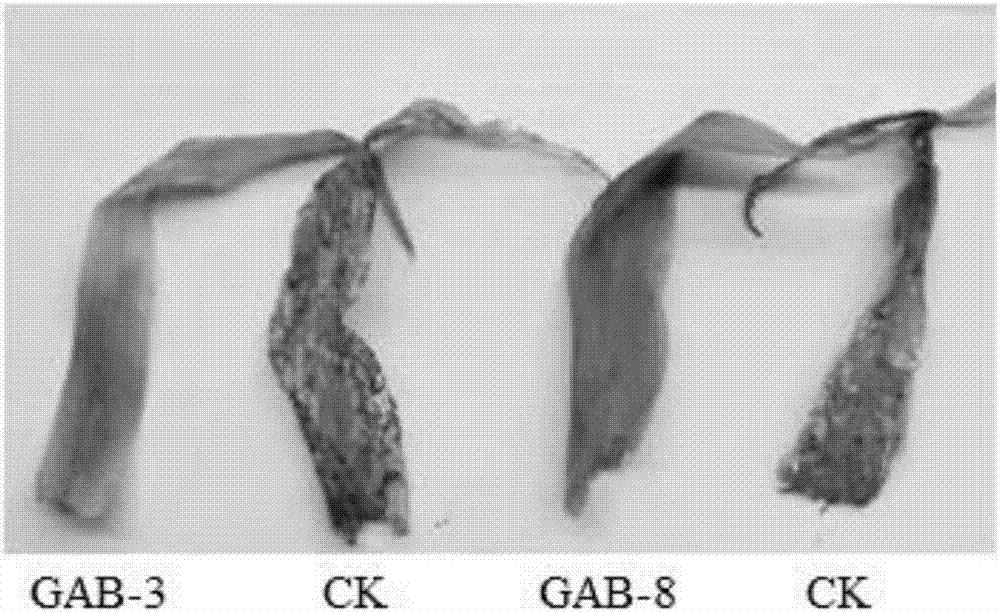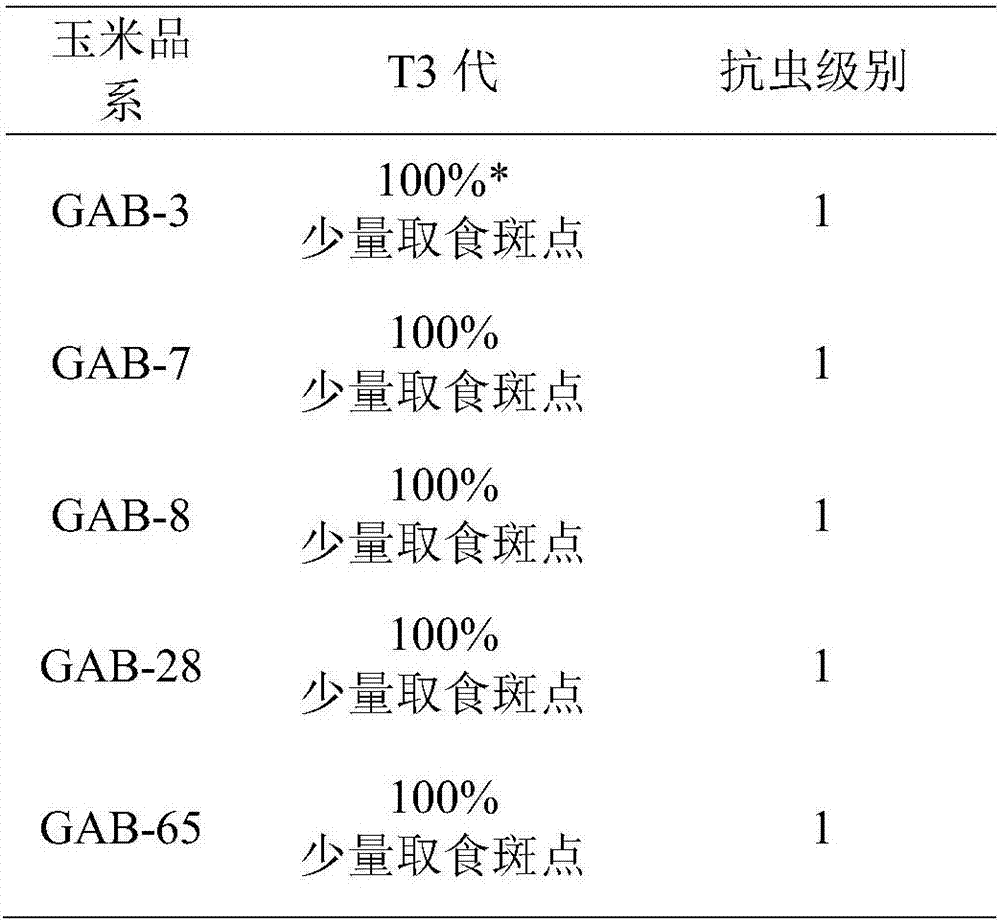Pest and glyphosate resistant expression vector, and plasmid and application thereof
An expression carrier and glyphosate-resistant technology, which is applied in the direction of using vectors to introduce foreign genetic material, application, and cells modified by introducing foreign genetic material, etc., to achieve the effect of delaying pest resistance and broadening the insecticidal spectrum
- Summary
- Abstract
- Description
- Claims
- Application Information
AI Technical Summary
Problems solved by technology
Method used
Image
Examples
Embodiment 1
[0031] Example 1, construction of expression vectors for insect-resistant protein coding genes cry1Ab, cry2Ab and glyphosate resistance gene G10evo
[0032] The plant transformation vector was constructed based on the pCambia 1300 (CAMBIA, Canberra, Australia) vector. The glyphosate resistance gene G10evo contains the nucleotide sequence of the maize acetohydroxyacid synthase chloroplast signal peptide (SEQ ID No: 3, the 5' end is designed with a BamHI restriction site, and the 3' end is designed with an Xho Ⅰ position point, BamHI-Xho Ⅰ fragment) and CaMV35S terminator (SEQ ID No: 4, Xho Ⅰ site is designed at the 5' end, HindIII site is designed at the 3' end, Xho Ⅰ-HindIII restriction fragment), A BamHI-HindIII fragment including the gene (with signal peptide) and terminator was obtained.
[0033] The 35S promoter of CaMV (containing the intron of rice actin) p35s-actinintron, using the PMD19-35Sints plasmid kept in the laboratory as a template, using the primer 35S-KpnIF (...
Embodiment 2
[0042] Example 2, the acquisition of transgenic insect-resistant and herbicide-resistant corn
[0043] The method used in the maize transformation event is the Agrobacterium-mediated method, and the transformation is carried out according to the method and medium formula reported by Frame et al. (Plant Physiol, 2002, 129: 13-22). The specific steps are as follows: take 8-10 days after pollination Hi-2 ear of corn. Collect all the immature embryos (1.0-1.5 mm in size), and transfer the T-DNA vector pCam-pZmUbi-1-cry1Ab-PepcT-pActin-cry2Ab-T35S-p35s-intron-
[0044] G10evo-T35S Agrobacterium and immature embryos were co-cultivated for 2-3 days (22°C). Transfer the immature embryos to the callus induction medium (containing 200 mg / L timentin Agrobacterium), and culture in the dark at 28°C for 10-14 days. All the calli were transferred to the selection medium with 50ng / ml hygromycin, and cultured in the dark at 28°C for 2-3 weeks.
[0045] All the tissues were transferred to th...
Embodiment 3
[0046] Embodiment 3, the acquisition of transgenic insect-resistant and herbicide-resistant rice
[0047] The transgenic plants were obtained according to the methods and medium formulations in the literature (Lu Xiongbin, Gong Zuxun, 1998 Life Sciences 10: 125-131; Liu Fan et al., 2003 Molecular Plant Breeding 1: 108-115). The mature and plump seeds were selected to be hulled, and callus was induced to be used as transformation materials. Take the Agrobacterium plate containing the T-DNA vector pCam-pZmUbi-1-cry1Ab-PepcT-pActin-cry2Ab-T35S-p35s-intron-G10evo-T35S, pick a single colony for inoculation, and prepare the Agrobacterium for transformation. Put the callus to be transformed into the appropriate concentration of Agrobacterium solution (containing acetosyringone), let the Agrobacterium bind to the surface of the callus, then transfer the callus to the co-culture medium, and co-culture for 2-3 sky. Wash the transformed callus with sterile water, transfer to the select...
PUM
 Login to View More
Login to View More Abstract
Description
Claims
Application Information
 Login to View More
Login to View More - R&D
- Intellectual Property
- Life Sciences
- Materials
- Tech Scout
- Unparalleled Data Quality
- Higher Quality Content
- 60% Fewer Hallucinations
Browse by: Latest US Patents, China's latest patents, Technical Efficacy Thesaurus, Application Domain, Technology Topic, Popular Technical Reports.
© 2025 PatSnap. All rights reserved.Legal|Privacy policy|Modern Slavery Act Transparency Statement|Sitemap|About US| Contact US: help@patsnap.com



